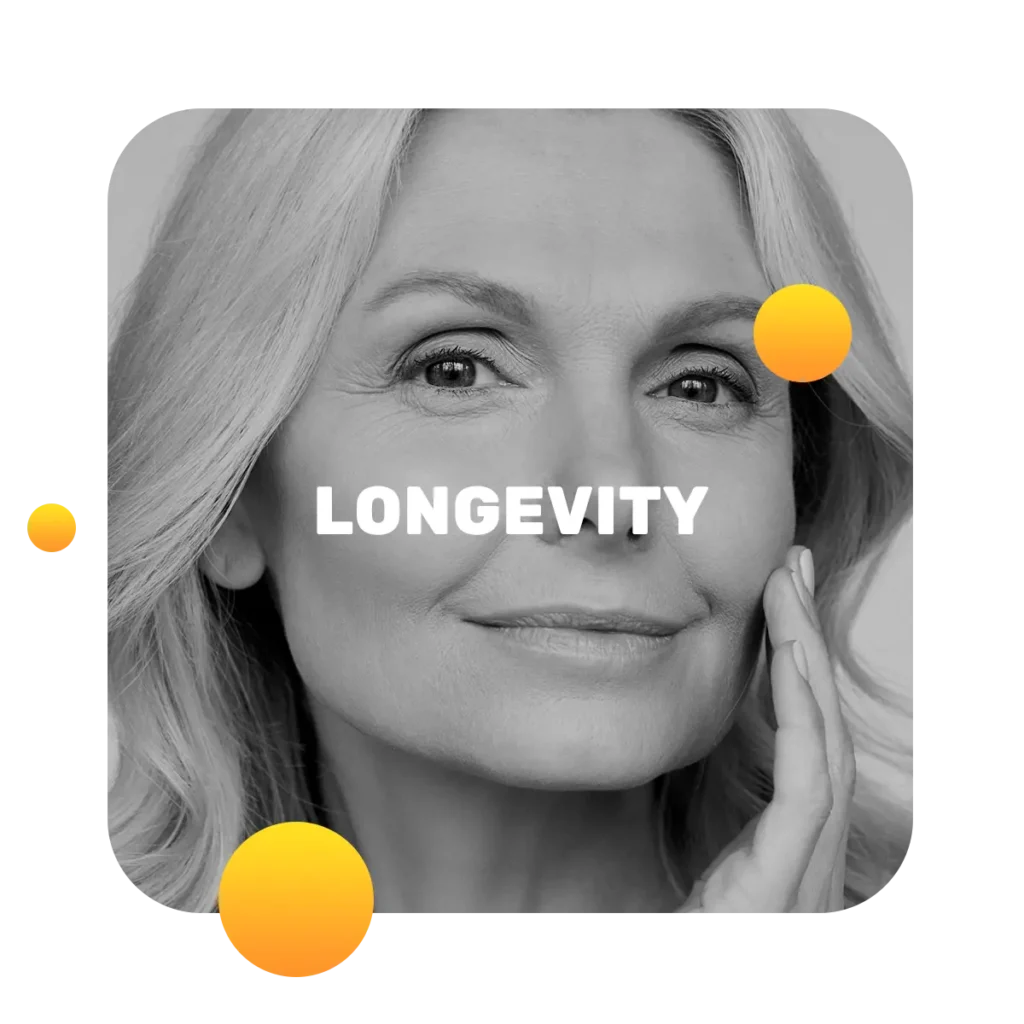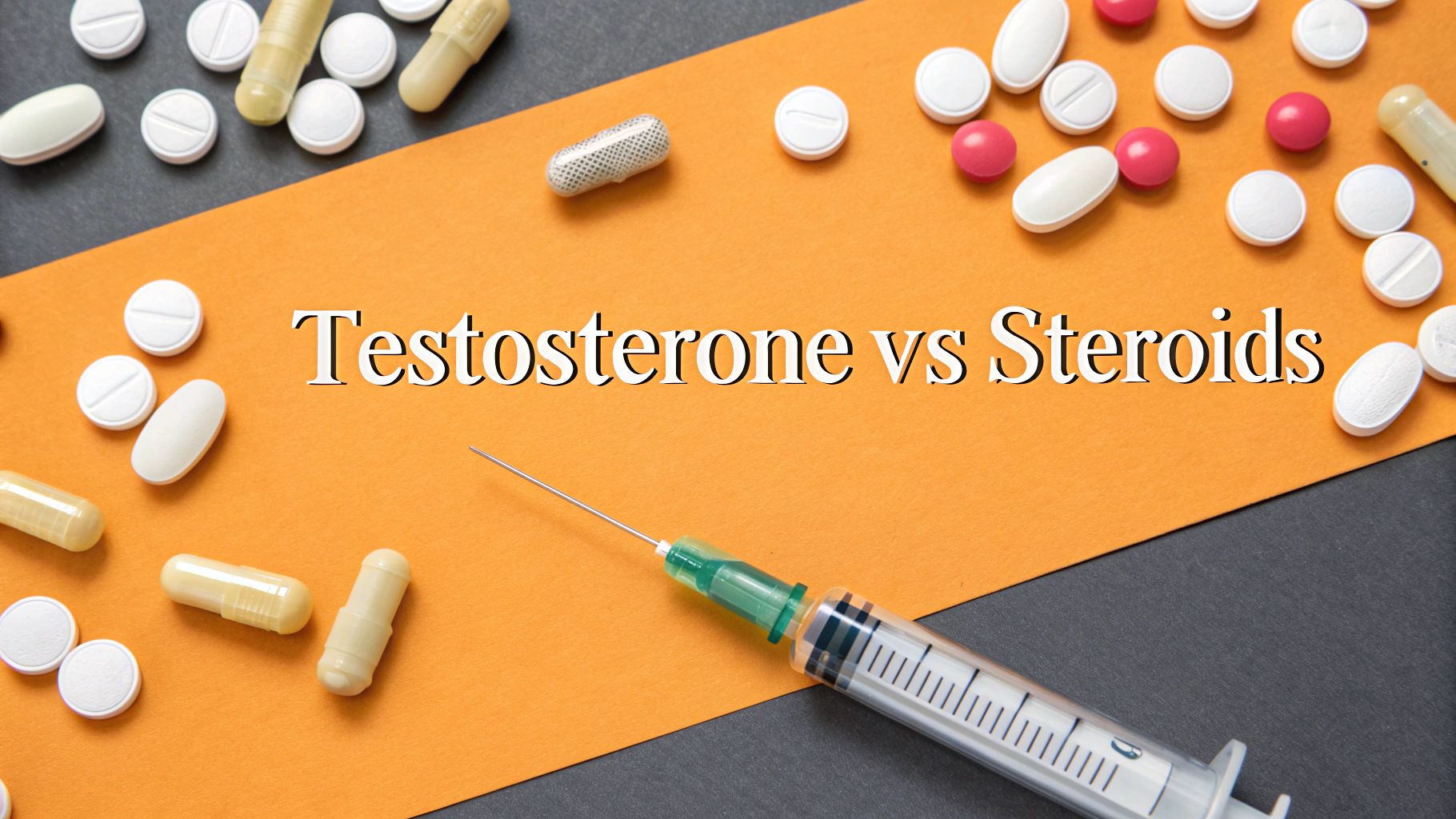How to Reduce Body Fat Percentage for Good

When you’re looking to get leaner, the real goal isn’t just dropping pounds—it's about creating a sustainable calorie deficit that targets body fat. This is done through a smart combination of nutrition and consistent exercise. The aim is a fundamental shift in your body composition, where you ditch the fat but hang on to your valuable muscle. That’s the core principle for building a healthier, stronger physique.
Losing Fat vs. Losing Weight: Why It Matters
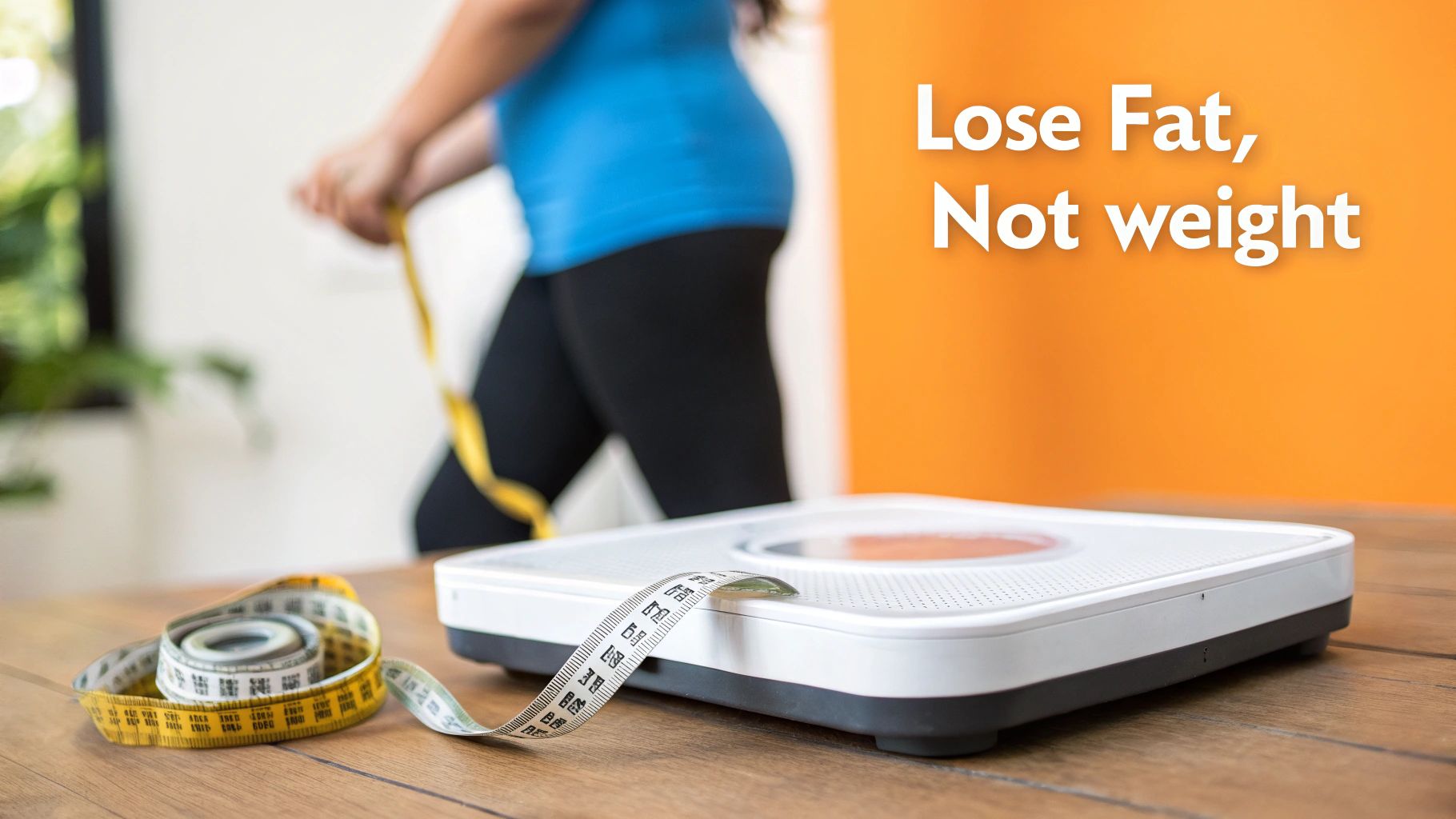
So many people use "weight loss" and "fat loss" as if they're the same thing, but they lead to completely different results. Chasing a lower number on the scale is often a trap. Your weight can jump around daily thanks to water retention, muscle gain, or even the carbs you ate yesterday. It's a seriously misleading picture of your actual progress.
The real prize is improving your body composition—the ratio of fat to lean mass (which includes muscle, bone, and water). Focusing only on what the scale says can push you toward crash diets and endless cardio, a surefire way to lose precious muscle right along with fat. That’s a huge mistake, since muscle is your metabolic engine, helping you burn more calories even when you’re just sitting around.
The Problem with Traditional Metrics
For decades, Body Mass Index (BMI) was the go-to for judging health. But it's a flawed tool because it can't tell the difference between muscle and fat. A muscular athlete could easily be flagged as "overweight," while someone with a "healthy" BMI might be carrying a high body fat percentage and hidden health risks.
This is exactly why we now focus on metrics like visceral fat—the dangerous stuff packed around your organs. Understanding and reducing this type of fat is far more critical for your long-term health than your total weight. Lowering body fat, not just weight, is what truly dials down your health risks.
"A focus on body fat percentage provides a more nuanced understanding of a patient’s mortality risk than BMI alone. While a higher body fat percentage is associated with increased mortality risk, greater fat-free mass is associated with a lower risk of mortality."
The Four Pillars of Sustainable Fat Loss
Learning how to successfully lower your body fat percentage isn't about some secret trick. It’s about building a solid, consistent strategy founded on four interconnected pillars.
This table breaks down the four essential components for effectively and sustainably lowering your body fat.
| Pillar | Its Role in Your Fat Loss Journey |
|---|---|
| Smart Nutrition | This is your foundation. It's all about creating a manageable calorie deficit without making you feel miserable or deprived. |
| Effective Training | Exercise is what shapes your body. It preserves muscle during a deficit and gives your metabolism a much-needed boost. |
| Restorative Recovery | Sleep and stress management aren't optional. They're critical for keeping your hormones balanced and ensuring you actually make progress. |
| Consistent Lifestyle Habits | Real, long-term results come from the small, smart choices you make every single day, not from short-term sprints. |
Each pillar supports the others, creating a powerful framework that helps you not just lose fat, but keep it off for good.
Global health data backs this up, showing that combining diet with physical activity is the most effective path forward. A modest daily calorie reduction of 500-750 kcal can lead to safe, steady fat loss, especially when you pair it with a mix of aerobic and resistance training. You can dig deeper into these evidence-based health guidelines from the World Health Organization.
Building Your Fat Loss Plate (Not Another Diet)

Let's be honest: the fastest way to fail at fat loss is to jump on another restrictive diet. Real, lasting progress isn't about eliminating entire food groups or suffering through bland, joyless meals. It's about building a sustainable way of eating that actually fuels your body, supports your goals, and doesn't make you miserable.
It all starts with understanding your energy needs. The engine of fat loss is a modest calorie deficit, but it has to be managed correctly. I've found that aiming for a reduction of 300-500 calories below your daily maintenance is the sweet spot.
This gentle deficit nudges your body to tap into fat stores for energy, but it does so without sounding the alarm bells that lead to muscle loss and a stalled metabolism.
Prioritize Protein. Always.
When you're putting together your meals, protein is the undisputed MVP. And no, it's not just for bodybuilders—it’s absolutely essential for anyone looking to bring their body fat percentage down.
Protein has a high thermic effect of food (TEF), which is a fancy way of saying your body burns more calories just digesting it compared to fats and carbs. Simple enough.
More importantly, a high-protein intake is your best defense against losing hard-earned muscle while you're in a deficit. This is critical for keeping your metabolism fired up. On top of that, it has a massive impact on satiety, helping you feel fuller for longer and crushing those cravings that can completely derail your progress.
As a simple rule of thumb, I tell my clients to aim for roughly 1 gram of protein per pound of their target body weight each day. This ensures you're feeding your body the building blocks it needs to stay strong and lean as the fat comes off.
So, if you're aiming for a lean weight of 170 pounds, you'd shoot for around 170 grams of protein daily. It might sound like a lot, but it's totally manageable when you spread it across your meals.
How to Build a Meal Around Your Protein Source
Stop thinking about what you need to cut out. Instead, start by focusing on what to add in. Build every single meal and snack around a quality protein source.
- Breakfast: Instead of a sugary cereal that leaves you hungry in an hour, go for Greek yogurt with berries or scrambled eggs with a handful of spinach.
- Lunch: Ditch that sad deli meat sandwich for a huge salad topped with a generous portion of grilled chicken or salmon.
- Dinner: Start with a palm-sized portion of lean steak, fish, or tofu. Then fill the rest of your plate with non-starchy vegetables.
This one mental shift ensures you hit your protein goals almost automatically.
Once your protein is set, load up the rest of your plate with fiber-rich vegetables and a sensible portion of complex carbs like quinoa, sweet potatoes, or brown rice. The best time for these carbs is around your workouts to give you the energy you need to perform.
Finally, don't fear healthy fats. Sources like avocado, nuts, and olive oil are vital for hormone function. A small serving with each meal boosts satiety and helps your body absorb nutrients. This isn't a "diet"; it's just a smarter way to eat—one that makes reducing your body fat feel like a natural outcome, not a constant battle.
Your Blueprint For An Effective Training Routine
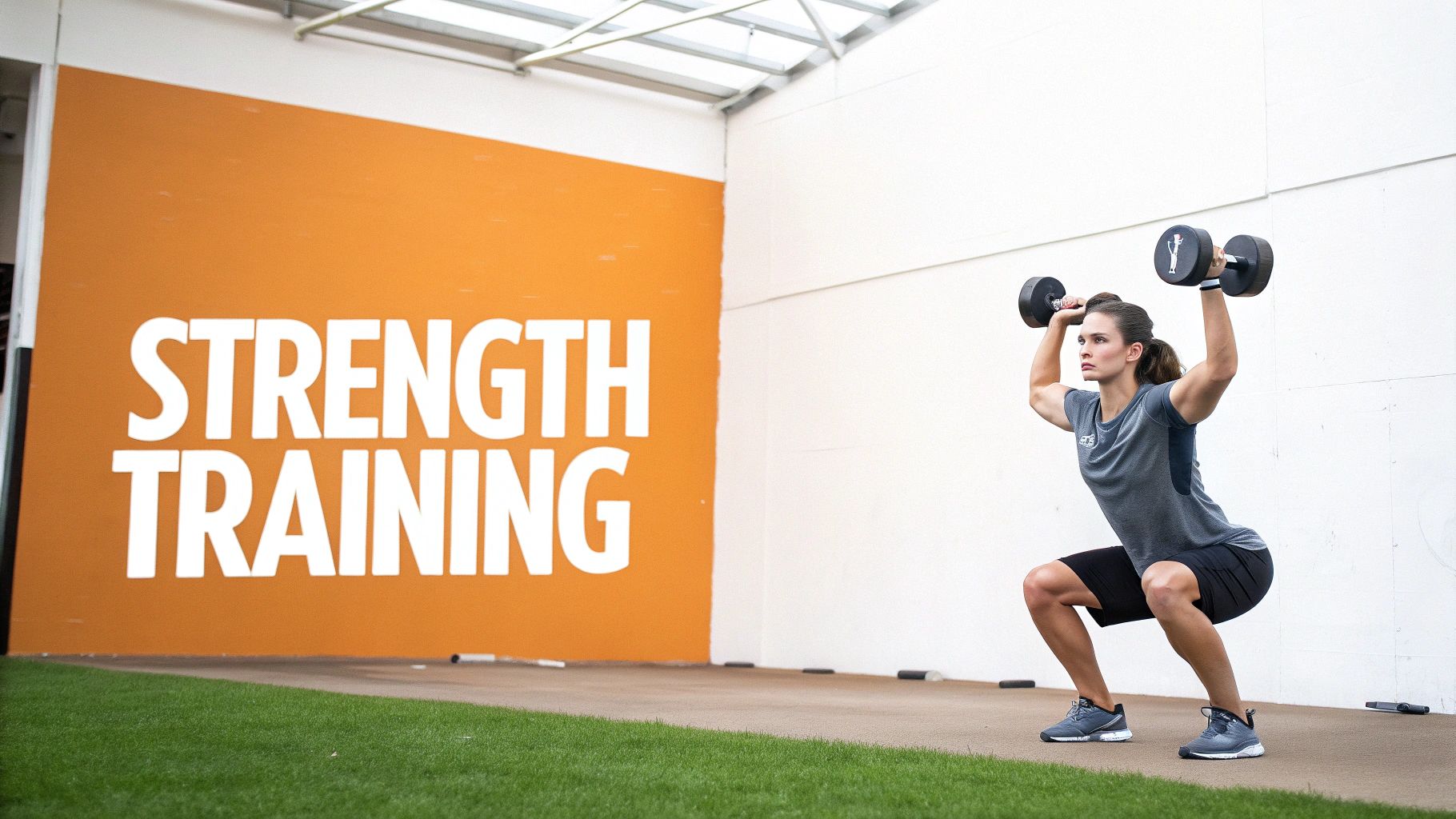
If nutrition is what sets the stage for fat loss, your training routine is the star of the show. A smart workout plan does so much more than just burn calories. It's the signal that tells your body to hang onto precious muscle while shedding fat, carving out a leaner, stronger physique.
Without a solid training plan, you risk becoming a smaller, but still soft, version of yourself.
The absolute cornerstone of any program designed to lower your body fat percentage is strength training. Hitting the weights sends a powerful message to your body: "This muscle is essential. Don't you dare get rid of it." This is a big deal because muscle is metabolically active, meaning it torches calories even when you're just sitting on the couch.
Preserving muscle is your secret weapon against the metabolic slowdown that often comes with a calorie deficit. When you prioritize resistance training, you make sure the weight you lose comes overwhelmingly from fat, not muscle. For a deeper dive, check out our guide on how to maintain muscle mass.
The Power of Progressive Overload
Just going through the motions at the gym isn’t going to cut it. The real secret to making continuous progress is a principle called progressive overload. In simple terms, it means you have to consistently ask a little more of your muscles for them to adapt and get stronger.
This doesn't always mean piling more plates on the bar. You can achieve progressive overload in a few clever ways:
- Increasing Reps: If you squatted for 8 reps last week, shoot for 10 this week with the same weight.
- Adding Sets: Instead of doing 3 sets of bench presses, push yourself to do 4.
- Reducing Rest Time: Shorten your rest periods between sets to crank up the overall intensity.
- Improving Form: Nailing your technique can engage the target muscles more effectively, creating a much better stimulus for growth.
Track your workouts. A simple notebook or an app is all you need to ensure you're always challenging yourself just a bit more than you did last time.
Choosing Your Cardio Wisely
Cardio is a fantastic tool for burning extra calories and boosting heart health, but it's not a one-size-fits-all solution. The two most common approaches are High-Intensity Interval Training (HIIT) and Low-Intensity Steady-State (LISS). Each has its place in a well-rounded routine.
A balanced routine often includes both. Use HIIT on days you're short on time and need a powerful metabolic boost, and use LISS for active recovery or when you want a less stressful, fat-burning session.
Making an informed choice between these two cardio styles can make a huge difference in your results and how much you enjoy your training. To help you decide, let's break down the key differences.
Choosing Your Cardio HIIT vs LISS
| Feature | HIIT (High-Intensity Interval Training) | LISS (Low-Intensity Steady-State) |
|---|---|---|
| Workout Duration | Short & intense (15-25 minutes) | Longer & relaxed (45-60 minutes) |
| Calorie Burn | High calorie burn in less time, plus an "afterburn" effect (EPOC). | Burns a higher percentage of fat during the workout. |
| Impact on Body | High-impact and stressful on the body. Requires more recovery time. | Low-impact and easy on the joints. Great for active recovery. |
| Best For | Time-crunched individuals, boosting metabolism, improving athletic performance. | Beginners, recovery days, stress reduction, building endurance. |
| Example | 30 seconds of sprinting followed by 60 seconds of walking, repeated 10 times. | A 45-minute brisk walk on the treadmill or a light jog in the park. |
Ultimately, the best cardio for you is the one you'll actually stick with. Mixing both HIIT and LISS throughout the week is often the most effective and sustainable strategy.
This kind of strategic approach to fitness is more important than ever. The global rise in body fat percentage has become a serious public health issue. Projections from the World Obesity Atlas 2025 estimate that the number of adults with obesity will likely double between 2010 and 2030 to over 1.13 billion. This makes understanding effective exercise strategies a personal and global priority. You can learn more about these projections and the call for increased physical activity from the World Obesity Federation.
Here’s the rewritten section, designed to sound completely human-written, natural, and expert-driven, following the provided style guide.
Mastering the Lifestyle Habits That Drive Results
What happens in the 23 hours you spend outside the gym often matters more than the one hour you spend inside it. Your daily habits can either supercharge your efforts or quietly sabotage them. Getting a handle on these crucial lifestyle factors is non-negotiable if you want to lose body fat for good.
Many people grind away in the kitchen and the gym but completely ignore the massive impact of sleep. When you're sleep-deprived, your body's hormone balance goes haywire. Levels of ghrelin, the "hunger hormone," spike, while leptin, the hormone that tells you you're full, plummets.
This hormonal chaos creates a perfect storm for overeating. You're not just hungrier; you're specifically craving high-calorie, high-carb foods. Consistently getting 7-9 hours of quality sleep is one of the most powerful fat loss tools you have.
Tame Your Stress and Cortisol
Chronic stress is another silent progress killer. When you're constantly stressed out, your body pumps out the hormone cortisol. While cortisol is useful in short bursts, persistently high levels send a clear signal to your body to store energy—specifically as visceral belly fat.
Managing stress isn't a luxury; it's a necessity for changing your body composition. This doesn't mean you need to meditate for an hour a day. It can be as simple as:
- Taking a 15-minute walk without your phone.
- Dedicating time to a hobby you enjoy.
- Practicing deep breathing exercises for just five minutes.
These small actions help down-regulate your nervous system, keeping cortisol in check and preventing your body from working against your fat loss goals.
Stress management is a skill, just like lifting weights. The more you practice it, the better you get, and the more resilient your body becomes to the fat-storing effects of cortisol.
Beyond stress, simple hydration plays a surprisingly large role. Water is essential for countless metabolic processes, including the ones that help your body burn fat for fuel.
Staying well-hydrated also improves workout performance and can even help manage hunger, as we often mistake thirst for a food craving. Aim for consistent hydration throughout the day, not just when you feel thirsty.
Finally, embrace the power of Non-Exercise Activity Thermogenesis (NEAT)—the calories you burn from all the movement you do that isn't formal exercise. Taking the stairs, parking further away, or pacing while on a phone call might seem trivial, but these small activities add up to a significant calorie burn over time.
Shifting your mindset from an "all-or-nothing" approach to one of "consistent, not perfect" is what truly unlocks lasting success and helps you lower your body fat percentage for the long haul.
How to Track Progress and Break Through Plateaus
To get real results in lowering your body fat, you have to become your own coach. That means tracking what actually matters, understanding the feedback your body is giving you, and knowing how to make smart adjustments when you get stuck.
First things first: forget obsessing over the scale. It's the wrong tool for this job.
Your body weight can swing by several pounds in a single day thanks to things like water retention, what you just ate, and hormones. Chasing a lower number on the scale is a recipe for frustration and can give you a completely misleading picture of your progress. Instead, let's focus on the metrics that tell the real story of your changing body composition.
Beyond the Scale: Measuring What Matters
The only way to see if you're truly losing fat—not just weight—is to use a combination of tracking methods. These tools give you a much clearer, more accurate picture of how your body is actually changing.
- Progress Photos: Snap some photos every two to four weeks from the front, side, and back. Try to use the same lighting, location, and time of day for consistency. You'll start to see subtle changes in muscle definition and overall shape that the scale could never show you.
- Body Measurements: Grab a flexible tape measure and track key spots like your waist, hips, chest, and thighs. A shrinking waistline while other measurements stay the same is a classic sign you're losing fat while holding onto valuable muscle.
These methods are fantastic for staying motivated because they reflect real changes in your physique. For a deeper dive, our comprehensive guide on how to measure body composition covers more advanced techniques and explains why they're so important.
Identifying and Breaking Through a Plateau
A real fat loss plateau isn't just a few days where the numbers don't move. It's when your measurements and photos show zero noticeable progress for at least three to four consecutive weeks, even though you've been sticking to your plan.
When you hit one, the worst thing you can do is panic and slash your calories. This is a time for a strategic tweak, not a desperate overhaul.
The goal isn't just to lose fat; it's to do so in a way you can sustain. A plateau is just feedback. It’s your body sending a signal that it's time to change one or two small things, not throw out the entire playbook.
This decision tree shows how often the root cause of a stall is something simple in your lifestyle.
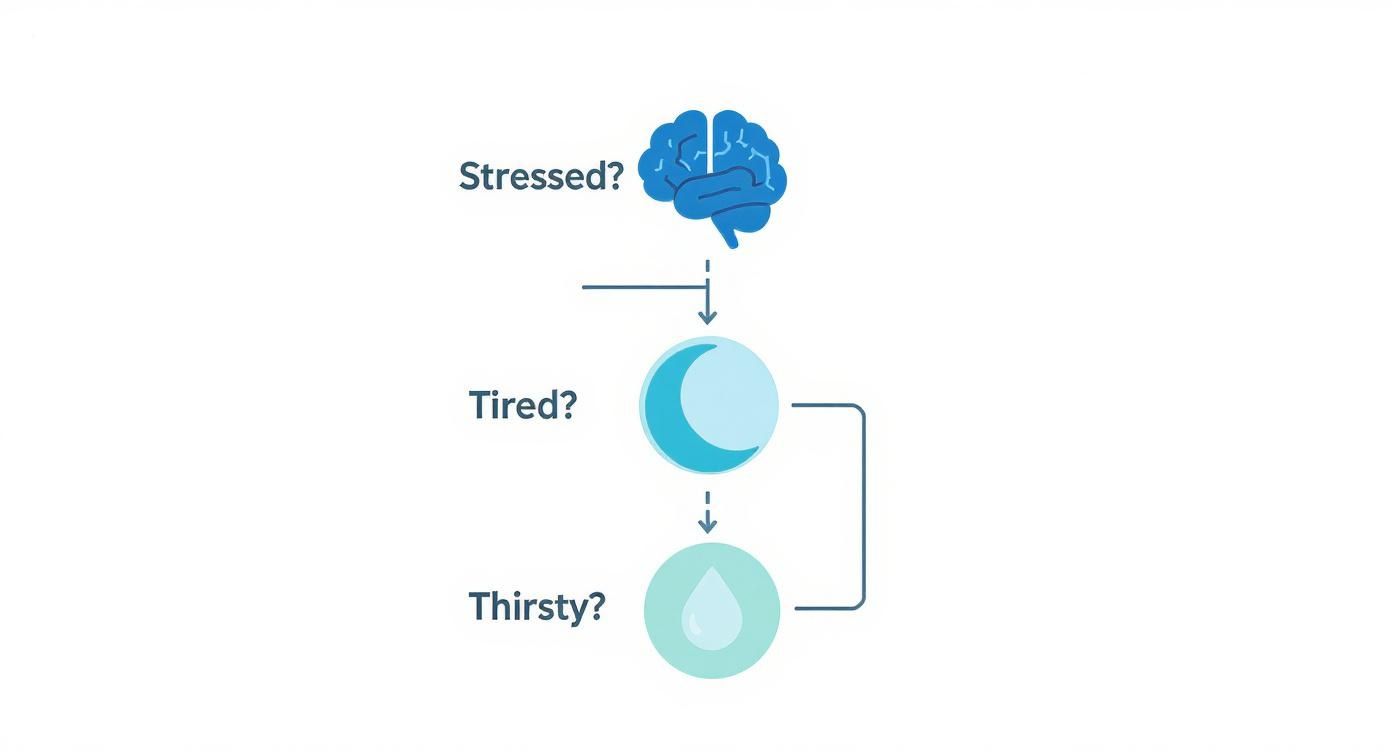
More often than not, the fix is as simple as getting more quality sleep, managing your stress, or just drinking more water—not starving yourself.
Before making any drastic changes, consider one of these small but powerful adjustments:
- Make a Minor Calorie Tweak: Reduce your daily intake by just 100-150 calories, pulling mostly from carbs or fats.
- Increase Your NEAT: Add a 20-minute walk to your day or make a conscious effort to stand up more often.
- Introduce a "Re-feed" Day: Once every week or two, bring your carbohydrate intake back up to maintenance levels for a day. This can help kick-start your metabolism and refill your muscle glycogen stores.
This is a skill worth learning, especially in the face of a global health challenge. Without intervention, projections estimate that nearly 60% of adults worldwide could be living with overweight or obesity by 2050. Understanding how to manage your own progress is more important than ever. You can explore the Institute for Health Metrics and Evaluation's findings to see the context behind these global health projections.
Common Questions About Body Fat Reduction
Navigating the world of fat loss can feel like dodging a constant stream of myths and misinformation. Let’s cut through the noise and tackle some of the most common questions that pop up on the journey to reduce your body fat percentage.
Getting clear, no-nonsense answers will help you move forward with confidence.
How Fast Can I Realistically Lower My Body Fat?
Patience is your greatest asset here. A healthy, sustainable, and realistic goal is to aim for a 0.5% to 1% reduction in body fat per month.
Pushing for faster results almost always backfires. It often leads to significant muscle loss, metabolic slowdowns, and a quick rebound that leaves you worse off than when you started.
Think of it as a marathon, not a sprint. This controlled pace ensures the weight you're losing is primarily from fat stores, all while you preserve the lean muscle you've worked hard to build. Slow and steady progress is what actually lasts.
Can I Target Fat Loss From My Stomach or Thighs?
Unfortunately, spot reduction is one of the most persistent myths in fitness. You simply cannot choose where your body burns fat from. Your genetics are in the driver's seat and will determine the pattern of fat loss.
Doing endless crunches won't melt belly fat, just like leg lifts won't slim your thighs. What those exercises do accomplish is building the muscle underneath. The best strategy is a comprehensive plan focused on lowering your overall body fat. As you get leaner, those newly defined muscles will become much more visible.
Your body loses fat in a predetermined pattern, much like peeling layers off an onion. You can't pick and choose which layer comes off first—you just have to keep peeling.
Are Supplements Necessary For Losing Body Fat?
No, supplements are not a requirement for losing body fat. The real, lasting results are always forged through consistent nutrition, effective training, and solid lifestyle habits. Nothing in a bottle can replace the fundamental work.
While some supplements like protein powder can be a convenient tool to help you hit your daily protein goals, they aren't magic bullets.
For those exploring more advanced options, our article on the best peptides for fat loss and muscle gain offers a deeper look into targeted therapies. However, you should always master the basics first.
Will Lifting Weights Make Me Bulky?
This is a common fear, especially among women, but it's entirely unfounded. Building a "bulky" physique is incredibly difficult. It demands a very specific, high-calorie diet and an intense, specialized training program over a long period.
For most people, lifting weights while in a calorie deficit will do the exact opposite. It helps create a leaner, more toned, and athletic look. Strength training is what allows you to build the shape you want as the fat comes off.
At Elite Bioscience, we provide physician-guided therapies to help you optimize your body composition and achieve your health goals. Explore our personalized treatment options to support your fat loss journey. https://elitebioscience.co
QUICK SEARCH
Make an account today to start your journey towards a better and healthier lifestyle.


